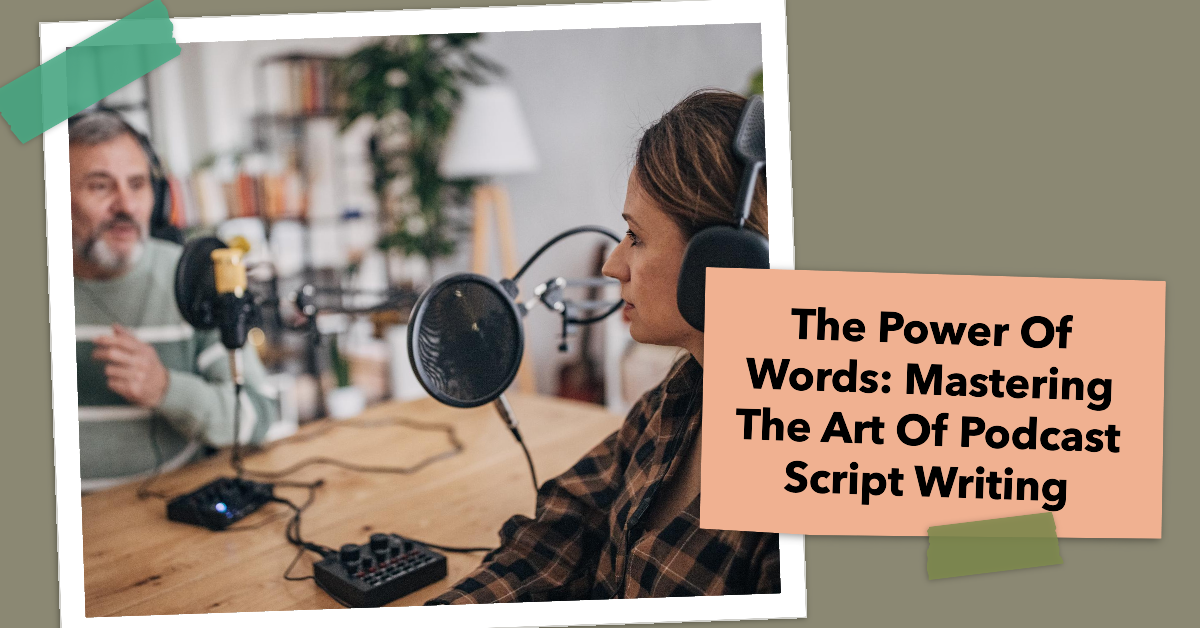
Podcasting is a billion-dollar industry. A report by the Business Research Company predicts that the global podcasting market will increase from USD 27.73 billion in 2023 to USD 36.67 billion in 2024, representing a compound annual growth rate (CAGR) of 32.2% during the forecast period.
The growing popularity of podcasts is largely attributed to shifting interests from mainstream media to social media. Podcast presentations also take on a conversational style, which resonates with most listeners.
However, like any industry, podcasting encounters its fair share of challenges. Many newly launched podcasts don’t make it past their first anniversaries.
Poor scripting is commonly cited as a major reason behind podcast failures.
But is there a right way to write a podcast?
Well, that question shall form the basis of this post.
Here’s a practical handbook on how to write a podcast script that’s sure to convert any passive listener to an active participant.
1. Lay Out Your Objectives

Starting to write a podcast without spelling out your goals is the surest way to set the program up for failure. So, before gathering your scripting materials (pen and paper, laptop, etc.), begin by defining the topic and theme that you intend to write about.
Clearly understand the purpose of the show and its target audience. That will allow you to choose a proper presentational style.
For instance, you could settle for a lecture format if you’re targeting beginners with little knowledge on the topic or opt for a conversational style if most of your listeners are experts.
It’s also at this point that you’ll determine whether the program will be prerecorded or streamed live. Bear in mind that either option will require proper streaming software.
Other key areas to define include episode length and number.
Podcasts can be as short as 10 minutes or as long as 5 hours, although 20 – 30 minutes is the ideal length.
As for the number of episodes, the limit is only your imagination and finances.
Lastly, determine the publishing cadence. Here, you can choose between a limited-run miniseries and an ongoing podcast that’s broken into seasons.
2. Work Out the General Delivery Outline
Once you know your podcast topic, target audience, and the program’s duration, it’s easy to work out a general outline.
A typical podcast template is one that outlines the main point, followed by a supporting point, supporting data, and a relevant quote.
Example:
Main Point: “An escalation of the Israeli-Iranian war threatens the peace of the entire Middle East.”
Supporting Point: “An all-out war would drag other nations, with each country picking a side.”
In this case, you could cite supporting data in which nations previously involved in shadow wars eventually went out guns blazing at each other, dragging other neutral countries into their conflicts. A supporting quote would be any saying by an expert, such as a seasoned politician or war veteran.
3. Choose Between Verbatim and Free-flowing Narration
Word-for-word narrations are ideal for fiction presentations. Consider this delivery style if you’re writing a podcast script about myths, legends, supernatural phenomena, and similar themes.
While it’s important to be creative while presenting a podcast, verbatim scripts prevent you from making potentially false or embellished claims while streaming your podcast on Twitch or similar platforms.
Free-flowing narrations are suitable when presenting non-fiction podcast topics that a host is conversant with.
In this case, you simply mention the main points that the presenter can pick and run away with.

4. Have a Powerful Introduction
A podcast introduction needs to be as captivating as possible. That’s especially if you intend to stream the program on Facebook or other social media platforms, where users have little patience to listen through sloppy presentations.
A perfect introduction should give your listeners an overview of the topic without giving much information.
The choice of words will depend on whether you’re a solo presenter or a co-presenter. It also depends on whether a guest or a panel of experts is in attendance.
Example:
Solo Host Intro: “Hello and welcome to (enter your podcast title), the show that discusses (insert the podcast’s theme or concept). In today’s episode, we’ll discuss (briefly introduce the topic for the day). I’m your host/presenter (mention your name).”
Co-host Intro: “Hello and welcome to (enter your podcast title), the show that discusses (insert the podcast’s theme or concept). We’re your hosts (say your names in turn).
In today’s episode,…..”
Guest or Panel Intro: “Hello and welcome to (enter your podcast title), the show that discusses (insert the podcast’s theme or concept). I’m your host/presenter (your name) and joining me today to share insights into (mention topic of the day) is (enter guest or panelists names, along with their titles and expertise).”
Note that certain wordings in your intro, such as your name and podcast title, will never change. However, you might consider having a tagline or some signature statement that your listeners identify the program with. Instead of simply introducing yourself as, say, Henri, why not add “Henri with an I?”
5. Subtly Mention Your Sponsor
For sponsored podcasts, mentioning the brand behind the program is prudent. However, the references should be subtle and not overly promotional.
It’s also important to mention the sponsor right in the introduction.
Example: “(Your podcast title) is proudly sponsored by (brand name). (Sponsor) is a company that (briefly describes the company’s industry, products, and values, and how they’re relevant to the podcast).”
6. Write As You Speak
Written texts are more formal than spoken speech.
So, if you want to write a naturally-sounding podcast script, you must write as you speak. This is especially recommended if you’ll also be the show’s eventual presenter.
Start by preparing a podcast script template and then note the key points. Now, explain each point loudly as though you’re talking to a close friend, then write down the explanations.
This podcast scripting technique is especially important for preparing an informal, conversational presentation.
7. Mind the Tonal Variations
Every podcast has indisputable truths, contestable facts, subjective opinions, and a bit of humor. It’s important to interrogate each subset to determine how to express it.
Adopt an authoritative tone if you’re stating a general or uncontestable fact and a more casual tone if expressing an opinion or making subjective statements.
Since you’re a scriptwriter and may not necessarily be the eventual presenter, you can give the host some cues on the right tone to assume, depending on the statement.
It’s easier to effect proper tonal variations for podcasts intended to be co-hosted. One speaker could handle all the serious talking while the other presenter infuses the much-needed comic relief.
Fortunately, there are many podcast hosting platforms designed with collaboration in mind. Such applications provide shared control among co-hosts, depending on their roles in the show.

8. Provide Context
If you’re recording a podcast to be presented in a free-flowing style, you’ll want to give context to each sentence. This provides you with clear ideas to build on.
A subtle phrase like “electric cars” may make perfect sense if you’re scripting a podcast on energy-efficient or eco-sustainable transportation.
The host will instantly compare the environmental impacts of battery-powered and petroleum-driven cars.
But if you’re podcasting about the top ten automotive trends of the 21st century, simply mentioning “electric cars” may not provide the much-required context.
In this case, you could go as far as to highlight pertinent facts, such as when the cars first emerged and the industry’s current size.
9. Remember the Segues
A segue allows for a seamless transition from one podcast topic or episode to another. The easiest way to achieve this transition is by using a phrase.
Example: “Having examined the benefits of feeding spinach to cats, the following session/episode will highlight how to properly incorporate this vegetable into your kitto’s diet.”
A segue could also be a sound effect. Fortunately, there are numerous options at your disposal.
10. Wrap It Up In Style
A podcast ending should be as captivating as the introduction and body. Now, there are two critical elements when learning how to end a podcast – outro and call to action (CTA).
The outro is the official summary. It should recap the key takeaways of the episode while suspension introduces the next topic.
Outrageous cliffhangers are totally acceptable. Just ensure each subsequent topic lives up to the hype.
Outro Example: “Well, that marks the end of today’s episode, where we discussed (enter episode topic). In today’s show, we were able to (briefly enumerate the points). Next week, we’ll (briefly introduce the next topic). Until then, it’s goodbye from me/us.”
If it’s a co-hosted show or one with guest appearances, ensure the outro comes right after everyone gives their closing remarks.
At the tail-end of the outro is where you’ll power your podcast with a call-to-action before bringing in a segue.
The CTA may be a general request to give a podcast more visibility. It could also be a call that encourages the show’s listeners to seek clarifications or purchase merchandise items.
Examples: “Thanks again for your time, feel free to like us on (mention social media platform). You can also share this episode on your social media handles.”
“Click on this link (enter hyperlink) to (record your questions, check out our new merchandise, etc.)”

Wrap Up
Podcast Writing is an art that requires patience and constant practice. However, following the above tips can help you ace any podcast script, regardless of the topic or presentation style. Remember that each podcast is unique. So, don’t suppress your creativity. You can incorporate quirks, provided they serve the program’s end goal.
